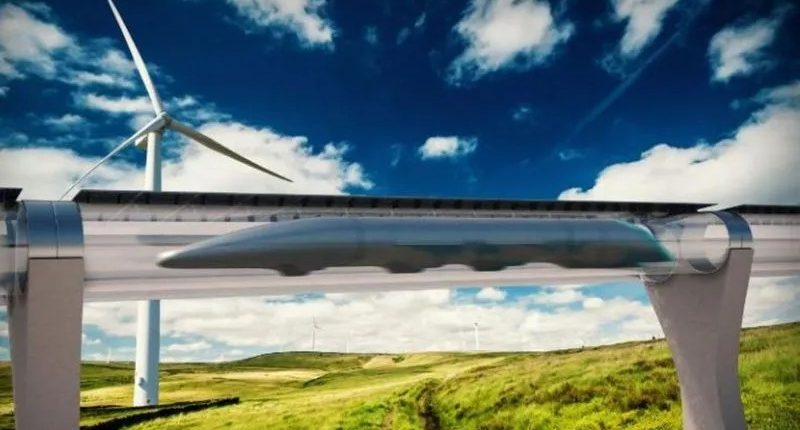CHINA’S revolutionary hyperloop train that aims to soar to speeds of 1,000kmph target has set an incredible new record.
The China Aerospace Science and Industry Corporation (CASIC) said it made “a significant breakthrough” in its latest test of the superfast shuttle.
The top space contractor first unveiled plans for the futuristic high-speed train in 2017.
The “ultra-high speed pipeline maglev system” – commonly known as a hyperloop – aims to travel at speeds of up to 1,000kmph (621mph) in a 93-mile vacuum tunnel between Shanghai and Hangzhou.
If successful, it would make the trains faster than commercial flights – which tend to travel at an average speed of 550mph.
Using vacuum-sealed tubes to transport passengers and cargo, the maglev system was first proposed by entrepreneur Elon Musk in 2013.
Read more on China’s trains
The system consists of just two things – a train, and a vacuum, instead of a train, rail, and tunnels.
In recent testing, China‘s hyperloop smashed previous records by travelling the full length of a 2km test track with stable levitation, CASIC said.
While the exact speed remains classified, it reportedly surpassed the previous record set by a maglev vehicle of 357mph – which the French V150 train hit in 2007.
During performance tests in November, the floating train shot to an impressive speed of 281mph.
Most read in Tech
The maglev technology means the train will “levitate” – eliminating friction as it travels through the vacuum tube.
The conditions reduce air resistance – achieving “near-ground flight” at ultra-high speeds.
The test track, located in Datong, Shanxi province, is the longest and biggest of its kind.
The project’s chief designer Mao Kai told Zhejiang Daily: “Science and technology progress step by step, and some aspects of this project are still in uncharted territory in China.
“Every step is challenging, and it’s a complex system.”
During the testing, engineers said they verified superconducting magnets, traction systems, and the safety of the overall system.
Zhang Yunjiao, a senior engineer with the state-owned China Railway Engineering Design and Consulting Group in Beijing, previously said the hyperloop project was “of strategic significance to China”.
The line is expected to be operational by 2035.
Several major cities were considered for the mega project – but the first line is set to open between Shanghai and Hangzhou.
It currently takes three hours to drive 175km between Shanghai and Hangzhou – but it could take just 15 minutes using the hyperloop system.
What’s a ‘maglev’ train?
Here’s what you need to know…
Maglev trains get their name because they use magnets to levitate the train slightly off the track.
This means there’s no wheels and it can travel faster due to less friction.
Journeys are also smoother than on standard trains.
They don’t need drivers because the track can tell them where to go.
Researchers are working on tube designs for the trains so that air resistance doesn’t stop them reaching their full potential.
So far, China’s high-speed rail service has reached 42,000km, ranking first in the world by the end of 2022.
There is already one maglev train in China, which connects the airport in Shanghai to the city centre – making the 19-mile journey possible in around seven minutes.
After its success, China Railway has been planning to expand the technology to connect their urban and rural areas.
China are the leaders in the high-speed railway development, but other global powers have also been developing their own high-speed trains to provide an alternative to flying.
Siemens and Bombardier have worked together to develop the ICE 3 – a family of high-speed electric trains that run between The Netherlands and Germany.
These trains usually travel at a maximum speed of 198 miles per hour, although trains running between Frankfurt and Cologne are allowed to run faster than 200mph to avoid delays.
Also in Europe is the Train a Grande Vitesse, or TGV, which was the continent’s first high-speed railway.
TGV continually surpass records for the highest speeds, and in 1990 they set the record of 320mph.
READ MORE SUN STORIES
They went on to smash it again in 2007 with the current record of 357mph.
And the high-speed rail network in South Korea has 71 train sets that can accelerate from 0 to 186mph in just 316 seconds.
World’s fastest trains
Here are the 10 fastest high-speed trains in the world…
- Shanghai Maglev – 460kmph (China)
- CR Harmony – 350kmph (China)
- CR Fuxing – 350kmph (China)
- DB ICE – 350kmph (Germany)
- SCNCF TGV – 320kmph (France)
- JR Shinkansen – 320kmph (Japan)
- ONCF Al Boraq – 320kmph (Morocco)
- Renfe AVE 103 – 310kmph (Spain)
- Korail KTX-Sancheon – 305kmph (Korea)
- Trenitalia Frecciarossa 1000 – 300kmph (Italy)
This post first appeared on Thesun.co.uk











